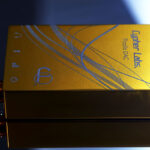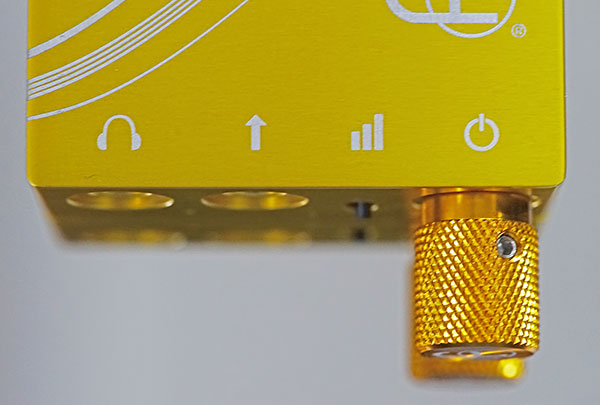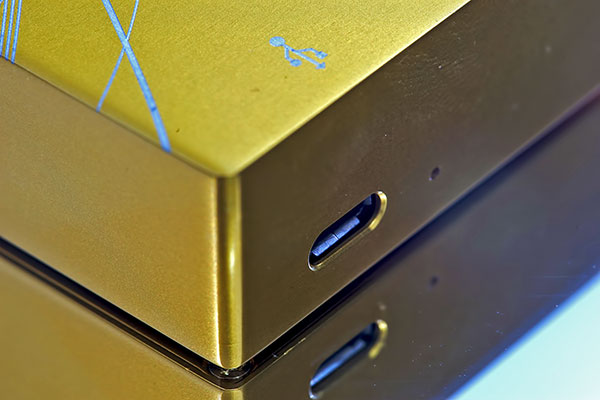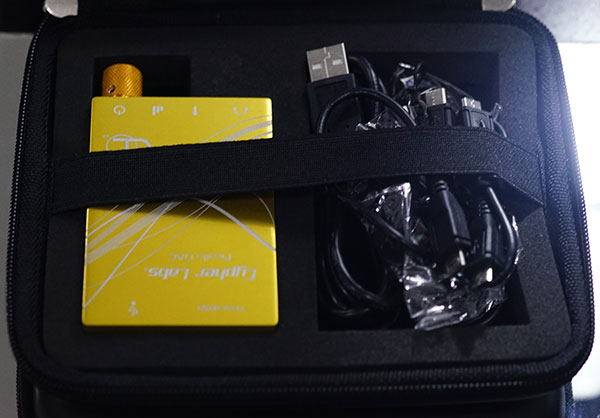This is a review of the Cypher Labs AlgoRhythm Picollo DAC, which is a blended version amp/DAC of their original portable analog Picollo amp. It is priced at $549.
Disclaimer: This is a sample sent to us in exchange for our honest opinion. Headfonics is an independent website with no affiliate links or status. We thank Cypher Labs for this opportunity.
To learn more about Cypher Labs products we have previously featured on Headfonics you can click here.
Note, that this article follows our latest scoring guidelines which you can read here.
2014 has been a very interesting year for Cypher Labs. It has seen them branch out into pure amping beyond their sophisticated and highly rated SOLO and Theorem 720 product lines. The Duet and Picollo portable amps by all accounts received some excellent reviews and showed that Cypher Labs could be a major player in the portable amping arena.
With the launch of the Picollo DAC things have gone one step further with the integration of the Picollo into a true IEM user lifestyle by launching a portable amp with an integrated DAC that was Android OTG compatible (native or otherwise) as well as PC/MAC plug and play.
The merging of phone devices with hi-res audio playback is how Cypher Labs started with the SOLO line a few years back so it has almost come full circle with the Picollo DAC except this time instead of Apple devices the Picollo DAC is aimed squarely at Android users.
The original Picollo amp was priced at $399 earlier this year so at $549 the Picollo DAC is quite a jump in price for those thinking the lack of Apple licensing requirements would have saved a pretty penny but of course, there is that additional DAC feature that you have to take into account.
Form and Function
Out of the box, the Picollo DAC is the exact same size and dimension as the earlier Picollo amp-only version despite the fact Cypher Labs have managed to pack a DAC inside the same chassis body.
The original Picollo AMP was actually a discrete component analog design using triodes that took up a certain amount of physical space inside the unit.
With the Picollo DAC Cypher labs have reverted to opamps instead of the original discrete design negating the need for hand-tuning and matching and at the same time increasing the amount of available space inside to allow for the additional DAC component.
Using Opamps have its pros and cons being much cheaper than discrete designs and implementations. They can also come with a preset level of tuning, resistance, impedance, and in turn elements of pre-determined tonality that can save a lot of time and money for manufacturers who in turn can focus on perfecting other components in the system.
The DAC
Cypher Labs curiously have turned to a Texas Instruments PCM2704 DAC as their decoder of choice inside the Picollo DAC which is not the highest resolving DAC chip on the market, not by a long shot topping out at 16/48 kHz.
Of course, it can be argued that this is a pragmatic choice given that currently Android outputs at a maximum of 16/44 but lest we not forget, firstly, USB Recorder Pro can output at 24bit.
Secondly, the Picollo is also a PC-compatible DAC and amplifier and on that basis, it is well short of the defacto expectation even by Cypher Labs’ own DAC design standards.
For now, though the vast majority of Android users will be well catered for in terms of bit rate capability with the Picollo DAC. However, what if Android in its next revision is able to decode at a higher rate? There stands a question mark on Picollo’s future-proofing value if Android’s capabilities grow and develop as a high-end digital transport.
Design
Beyond that Cypher Labs’ bullion bar-type of approach to the design and form of the Picollo DAC is to be commended. The build quality is very solid, more so than a lot of other portable DAC and amps out there on the market right now.
The machined aluminum enclosure reminds me of an Apple-like unibody type with very few design joints except on the lower casing. Physical measurements wise the Picollo DAC is 20mm x 53mm x 88mm which is almost the same height as the diminutive FiiO E11k and the rather more expensive VorzAmp Duo.
It is marginally thicker than the Duo by 2mm which officially measures 83mm x 66mm x 18mm but putting them up side by side they are exactly the same length so not sure where Vorzuge gets the 83mm length idea from.
The Picollo DAC though is a fair bit narrower than the Duo being more akin to the E18k in length and width. The Picollo DAC comes in silver, grey, and a sort of ‘goldmemberish freaky-deeky’ gold. I got the gold one – it’s super shiny and just so well…gold!
I/O
Inputs and outputs for the Picollo DAC are your standard analog line in and headphone jack output on the front panel and a single Micro USB input on the rear panel for both charging and DAC functionality from both OTG and regular USB output from your PC or MAC of choice.
There is a tiny gain switch between the volume pot and the line-in jack though curiously the labeling doesn’t state which level is which instead of using a stepped bar logo indicating the gain function.
Gain
The gain switch is incredibly tiny and almost flush with the panel. I get that in terms of moving around you do not want to accidentally hit the gain switch and blow your ears off though I would have preferred the labeling to be more intuitive out of the box so I know what gain setting I am starting with.
There is a 23.5db gain swing between all three settings, the low gain starting at -12db up to the highest setting at +11.5db. That is a significantly larger swing than say the VorzAMP Pure II which is 16db in total though the Pure II has a higher “high gain setting” at 15db than the Picollo DAC.
Using a DX90 and a Westone W4 with the volume set at 200, high gain comfortable listening was around 8-9 am on the volume pot, and mid-gain was closer to 12 noon on the pot. Low gain required me to pump up the DX90 volume to 225 as the pot maxed out on 200.
The most appropriate setting seemed to be around 210 on the DX90 for comfortable control on the Picollo DAC low gain setting. Also compared to some forum reports on the previous Picollo amp I didn’t hear any noticeable pot “scratch” on any gain setting nor any channel imbalance on high-gain at really low volume with the new DAC version.
Power
The power settings of the Picollo DAC have also been slightly reduced for lower impedance or higher sensitivity headphones and earphones over the regular Picollo discrete amp.
The DAC version delivers 40mW less than the amp-only version into 32Ω. Part of the claim of the Picollo DAC is its greater flexibility for IEM users over previous versions and other units in their line up so reducing the power for a lower ohm load makes sense.
Of course, the micro USB doubles up as a charging and OTG connector for your Android phones. Some OTG-compatible cell phones will be direct digital Audio OTG like the Samsung S3, 4, and 5, and others will be compatible through USB Audio Recorder Pro.
The level and type of connectivity are kind of hard to just outright confirm but as a general rule of thumb, I tend to veer to the branded labels for direct audio OTG out rather than use the reliable but user-unfriendly USB Audio Recorder pro.
Battery Life
Charging is done via USB and you can use the normal functions of the Picollo DAC whilst charging. Much like Vorzuge’s prized amps Cypher Lab’s Picollo DAC has excellent battery life, ranging from a respectable 12-18 hours when used with the DAC to an almost class-leading 24 hours when used purely as an amp.
My road testing so far with it has it close enough on the DAC lower end range around 12-14 hours and a little more towards 20 hours on a full charge as an amp.
Your mileage may vary but this is a huge step up from even great amps like the Cayin C5 which has only around 50% of that battery life at 12 hours rated and is almost equivalent to the Duo which is rated at around 26 hours playback time (my own experience of the Duo has been ever so slightly lower).
Now technically the Picollo, though Android OTG compatible, does not work as an OTG to Ibasso’s new DAC range or the DX100 sadly after testing. I was kind of hoping I could unearth some secret gold ticket but sadly no.
Power Bank
But here is something that threw up an interesting end result with the DX90 and DX50 and that is some sort of passive power bank pseudo function when using the micro USB to micro USB connector supplied with the Picollo DAC.
Now I say pseudo because I cannot confirm it is actively charging other than the little charge icon on the battery of the DX90 comes on when plugged into the Picollo DAC via USB. This could be a false signal from the DX90 thinking it is receiving a potential battery charge but in fact, it may not be.
Packaging
In a world of oriental silk and suede cloth pouches and utilitarian plastic sacks Cypher Labs actually nailed the one thing I have been asking amp manufacturers to do for ages and that actually create a proper case for their portable amps much like IEMs have their own carry cases.
I mean you drop $549 for a solidly crafted amp, a gold one at that too, and then normally hit the local hypermarket looking for anything to put it in to safe keep it. It makes no sense for amps not to have something hard and durable to protect it.
Most companies throw in a cursory soft velvet or leather pouch but Cypher Labs got the whole hog with a very nice zipper hard case with foam cut out for the amp and accessories. That is going the extra mile for me and easily worth $30 – 40 in added value. It’s got pimp value which is very Zen for the headphone local meets.
Apart from the case, the Picollo DAC comes supplied with 2 short micro USB to micro USB connectors, a short analog 3.5mm IC, a regular length micro USB to regular USB for your PC or Mac, a leather cushion strap, and 2 two rubber straps for stacking.
Sound Impressions
Summary
I have not owned or tested the previous Picollo amp so I can’t draw any direct comparisons but tonally the Picollo DAC comes across as warm to neutral with a very smooth response from top to bottom.
The top end lacks a bit of headroom extension compared to some other similar-priced amps such as the Duo and the bottom end has a very slight mid-bass elevation but nothing distracting or dominating.
The presentation is more smooth and clear than dynamic and clean for me personally using the W4. It is not as rich and lush as Duo but it has the type of presentation that is easy on the ear and very non-fatiguing.
Bass
The Picollo’s gentler easy on the ear approach might not make it the most throat-grabbing bass experience but it doesn’t mean it is bass light or bloated and slow, just not as forward and aggressive as say the DX90’s own dynamic bass presentation or the thicker weight of the VorzAmp Duo, especially with the bass switch flicked on.
However, Picollo’s bass more than makes up for that lack of aggressive midbass slam from other amps by projecting good detail, tight articulation, and zero sloppiness or excessive bloat.
Mids & treble
Mids are the strongest asset of the Picollo Amp and perhaps a bit more forward than the bass and treble section making them feel more prominent in the overall presentation. Vocals, in particular female vocals, sound excellent with fantastic grain-free control.
Recordings from the likes of Agnes Obel project a very close perspective and are very prone to sibilance both in terms of how they were recorded and how some amps react to her breathy semi-whispering type vocals.
The Picollo DAC keeps everything in place perfectly whilst retaining a high degree of fun and musicality throughout. Like J. Gordon Holt famously states, “If the midrange isn’t right, nothing else matters” so I am glad to see Cypher Labs pay particular attention to the tuning for the mids on the Picollo DAC.
The treble on the Picollo DAC is slightly rolled off compared to the mids and bass but never really comes across as syrupy or too colored. Now that might be fine for some matches and people’s tastes but for me personally, I would have liked to have seen just a bit more extension and a slightly more forward presence just to give give it more air and a greater sense of space.
Noise levels
Background noise is zero on the Picollo DAC, which, judging by the review of the Picollo amp before it, solved the omnipotent impression that Cypher Lab’s amping was tuned primarily for headphones and secondary for IEMs at a certain level of sensitivity.
Every single IEM I threw at the Picollo DAC came up with the same very low background noise result which was very reassuring. For reference, this included the UE900, T10i from RHA, Westone W4, UM Merlin, 64 Audio’s V8, AWW’s W300AR, Heir Audio’s 8.0, Dita’s The Answer and the Minerva Mi-Pro Artist CIEM.
All of them have varying degrees of efficiency ranging from 16ohms right up to 35Ω with the Heir Audio 8.0 which benefited greatly from the additional controlled amping in terms of weight and dynamics.
Synergy
My ‘go-to’ IEM has been the Westone W4 for some of my recent reviews and it pairs quite nicely with the Picollo DAC’s rather smooth and slightly neutral presentation. It is not the most expensive and can seem slightly dated now compared to higher-end customs but it can be much more forgiving especially on upper mids and vocals in comparison.
The Dita ‘The Answer’ dynamic driver also sounded excellent. It also had much more life in the treble than the W4 and a bit more of a cutting edge in female vocals as well as having a wider and deeper soundstage than the W4.
Perhaps my favorite match though was the Heir Audio 8.0. That huge soundstage of the 8.0 added a much-needed extra dimension over the W4 and Dita as well as being equally as forgiving, lush, and smooth as the W4’s midrange. Interestingly I found the 8.0 was also a bit easier to drive than the Dita which I hadn’t expected given the higher impedance of the 8.0 (35ohms).
The Samsung S3 experience
Yup, it works, it’s simply plug-and-play exactly as Cypher Labs stated, and given it is a Samsung Galaxy S3 it also does digital audio direct out via OTG instead of having to work the magic through a USB Audio Recorder Pro app.
Compared to direct out of the jack of the S3 the Picollo on OTG cleans up the signal really nicely producing a much smoother, grain-free, and spacious sound than the S3 is capable of. The S3 is not the worst of the cell phones out there by a long shot but the Picollo is a clear upgrade.
Compared to similar setups such as the FiiO E18 the Picollo DAC doesn’t have quite the same treble extension and sense of space but its a lot smoother and more controlled with a superior midrange – perfect for long bus journey listening sessions.
Our Verdict
This is the best “gold” amp I have ever heard period!! Ok, so it’s the only gold amp I have ever had period! However, getting past the sheer ‘goldness’ of my review unit (I think it shines all by itself at night but can’t be sure) I have to admit my impression of the Picollo DAC has been largely positive with one or two concerns.
The DAC is the biggest weakness in the chain with its lack of future-proofing over any possibility Android might switch to 24-bit resolutions at some later stage. Remember this is a $150 upgrade on the discrete amp version and a move to opamps also.
Thankfully the stellar build quality, excellent battery life, a more than a satisfactory amp, and pleasing tonality of the Picollo DAC should allow it to pass the demo test for most discerning audiophiles with relative ease.
Cypher Labs AlgoRhythm Picollo DAC Specifications
- Sampling Rate: 32, 44.1, 48 kHz @ 16-Bit
- DAC IC: Texas Instruments PCM2704
- Frequency response: 20Hz-50kHz ±1dB
- 160mW into 32Ω
- 90mW into 50Ω
- 60mW into 300Ω
- 30mW into 600Ω
- <1 Ω Output Impedance
- 12-18 hours of playtime from Android OS devices
- 16-24 hours of playtime from analog devices
- Continuous playtime when using computers
- Built-in Rechargeable Lithium-ion battery Sanyo UF103450P 2000mAH/3.7V
- Standard 5 volt 1 amp USB recharge time < 4 hours.
- Size: 20mm x 53mm x 88mm (100mm with knob)
Weight 5oz / 145grams






